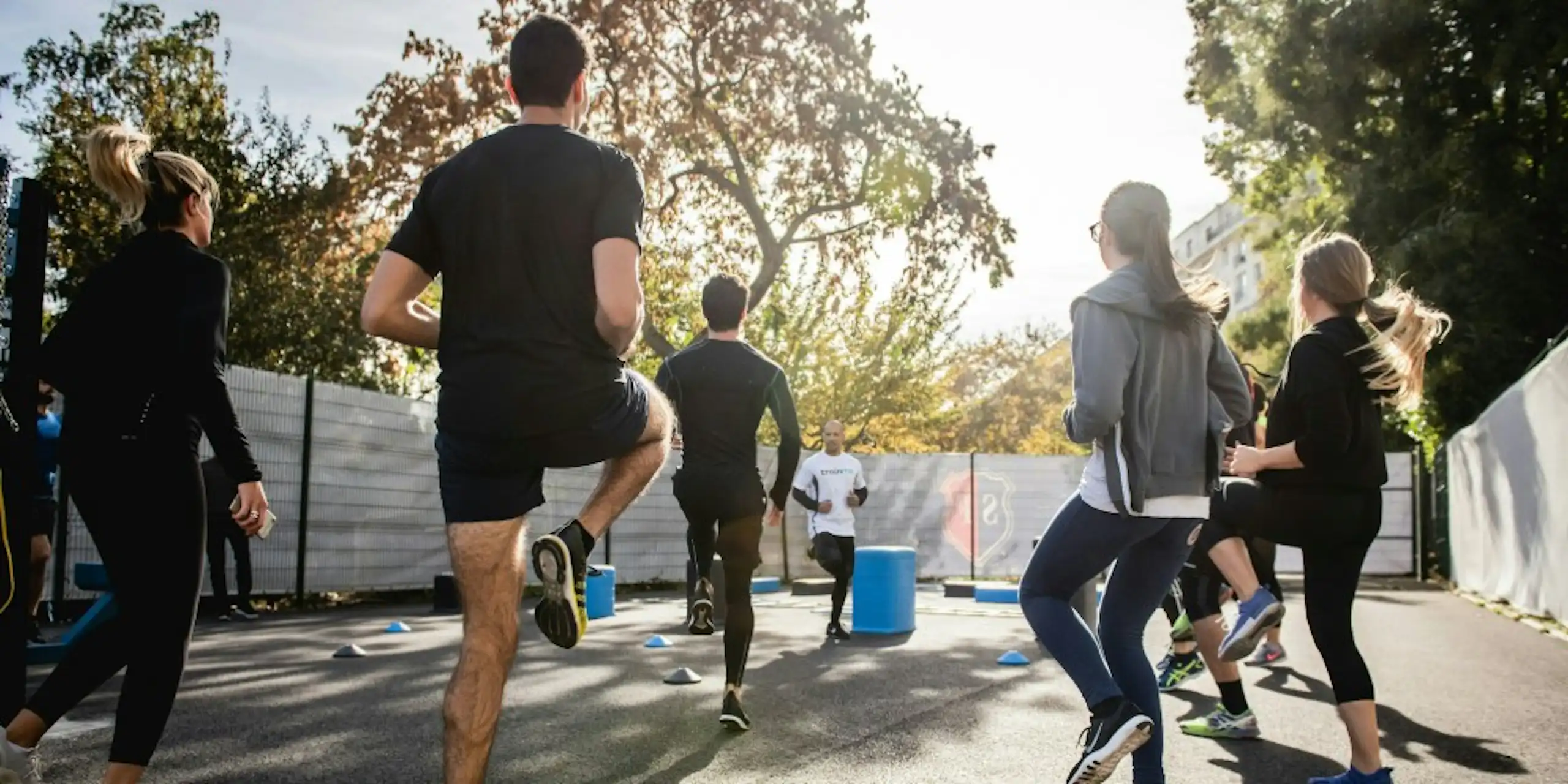Latest
Promoting Physical Activities and Wellbeing at Work

In the modern day, wellbeing is typically associated with positive mental health whilst fitness is correlated to an individual’s physical health. In truth, fitness and mental health make up an individual’s wellbeing.
This disparity is often missed by organisations when developing a working culture and environment. Senior leadership may put measures in place to manage and boost the mental health of their people, but by ignoring the physical wellbeing of individuals, they could be negatively impacting their mental health despite their efforts.
Promoting physical wellbeing in the workplace has a direct impact on mental health and overall wellbeing, which feeds directly into the productivity and efficacy of an organisation.
What is physical wellbeing?
Physical wellbeing relates to a person’s lifestyle choices. This could be their exercise regime, diet, hygiene, relaxation and the amount of sleep they get. The cyclical and symbiotic relationship between physical and mental wellbeing is well documented.
Stress, anxiety, depression and other mental health conditions can prevent a person from maintaining a healthy diet and regularly exercising. Failing to get some element of movement in your day can lead to things like depression and anxieties over self-image, etc. However, physical wellbeing is more than undertaking physical activities, as it encompasses activity and mental health.
Undertaking physical activities could relate to a myriad of exercises and methods. There are obvious methods such as running, walking, taking part in different sports, regularly attending the gym. However, regardless of whether people recognise it or not, they will be taking part in some sort of physical activity each day.
It might be stretching when they wake up, walking to work, taking the stairs, all things most people do each day. These simple behaviours can truly be of great benefit to a person’s wellbeing, reducing the symptoms of stress, centring them and improving their mindfulness.
How can businesses promote physical wellbeing at work?
Organisations and their senior leaders need to better understand the relationship between physical activity and overall wellbeing. We have previously created a comprehensive list of how senior organisational leaders of workplace wellbeing initiatives painting a complete picture of workplace wellbeing.
It may benefit an organisation greatly if they implement physical wellbeing incentives for their people. These incentives do not even necessarily have to be based out of the regular working environment. Here are a few methods and incentives that can encourage physical wellbeing in the workplace:
Active space
Active spaces are a fun and simple way to encourage physical activity amongst people in the workplace. It blends movement with working and productivity, boosting engagement and overall mental wellbeing.
These spaces may revolve around standing desks, under desk treadmills, exercise ball or exercise bike machines, or it could be as simple as encouraging relaxation breaks where individuals can walk and stretch their legs. Active spaces simply encourage people within the organisation to take part in basic physical activities throughout the day to keep them engaged, alert whilst managing their wellbeing.
Walking meetings
In office roles, there is a lot of sitting down, either in front of screens or in meetings. One simple and quick way to resolve this issue is for organisations to encourage walking meetings.
This may be outside, throughout the building or short walks from area to area. The concept may seem needlessly complicated and unnecessary when taking notes, but for conveying simple messages or catch ups, walking over short distances can lift the mood whilst encouraging basic physical activity.
Gym and yoga classes
The government notes that being inactive at work is as dangerous to an individual’s health as smoking. It is estimated that individuals, especially those in office-based roles might spend up to three-quarters of their days sat down.
This can lead to health issues such as DSE injuries such as a musculoskeletal disorder or increase their stress and anxiety levels due to reduced physical wellbeing. Because of this, senior organisation leaders can incentivise physical activity through corporate yoga or fitness classes.
These classes can be used to counteract and overcome the adverse health effects of prolonged periods of sitting. It provides an outlet to an organisations people a break from these extended periods of sitting down, staring at a screen or typing.
Corporate yoga classes in particular are excellent for reducing stress and anxiety and can be easy to implement. It can be done remotely with a qualified yoga teacher; dedicated spaces can be created for scheduled classes or senior leadership can encourage its people to participate in desk or chair yoga so they do not need to leave their dedicated space and can do it throughout the day.
Group/team challenge
To easily promote physical wellbeing within an organisation, team fitness challenges can easily inspire sudden short-term behaviour changes which can lead to prolonged physical wellbeing. By adding a competitive and fun gaming element to physical wellbeing amongst your people, they are more likely to be receptive to the initiative.
These challenges might include step counter challenges to see who does the most in a day, push-up challenges with the aim of a team surpassing a certain amount of push-ups over a period of time or it could be something simple such as a hydration tally, where individuals keep track of the amount of water they drink in a day.
These challenges not only promote cohesion amongst an organisations people, but it adds a fun element for them to engage in whilst promoting their physical wellbeing. These types of incentives can encourage healthy behaviours and attitudes, improving not only physical but mental wellbeing simultaneously.
Encourage active breaks
Active breaks are short breaks taken throughout the day typically in 5-to-15-minute intervals where individuals can focus on relieving stress and improving their physical wellbeing. These breaks and the activities undertaken during them can vary in levels of complexity and time.
Some can be as simple as taking a break to stretch or go for a short walk around a workspace, others may relate to short active workouts completed by following routines and instructions. Whilst these breaks are short, they can improve workplace performance through reducing pressure and offering individuals some relief during stressful working periods, simultaneously energising them to continue operating at a high-level of efficacy.
Whilst individuals may remain active during these periods, they will be effectively giving their mind respite from working pressures allowing them to refocus and improve upon their overall wellbeing.
The benefit of physical activity in the workplace
It is estimated that approximately 38% of people over the age of 16 in the UK are partaking in under 150 minutes of physical activity a week. This can be due to a variety of factors, but one of the key issues could be identified as the link between mental and physical wellbeing.
If a person is struggling with their mental health and experiencing high levels of stress, they will likely be experiencing feelings of exhaustion, preventing them from partaking in physical activity to improve their overall wellbeing. With the average person spending approximately a third of their life in a working environment, it can be assumed that much of the stress people experience in their lives could be caused by their working conditions preventing them from following an effective physical wellbeing routine.
As previously mentioned, the link between physical and mental wellbeing is extremely close, as an impact on one directly affects the other and can lead to a cycle of being unable to correct either. Without physical activity, a person’s mental wellbeing can be negatively impacted, resulting in mental health conditions such as depression and anxiety, making them less productive and effective in the workplace. Promoting physical activities in the workplace is not only integral to an organisation’s people, but also the success of an organisation.
Regular physical activity such as basic daily routines can enhance creativity and improve focus in individuals. Studies have been conducted to review the impact of promoting physical activity to improve wellbeing in the workplace and it was found that these activities could effectively combat absence rates.
This is just one demonstration of the benefit of promoting physical activity in the workplace to an organisations people. On a base level, people are more likely to engage with an organisation that recognises the need to uphold their overall wellbeing, making them more productive and integral to growth. It will inspire them to work alongside their colleagues, promoting togetherness and generally create a more open and inclusive working environment.
Promoting physical activity is a necessity for organisations to thrive. It protects and inspires its people, and the benefits are numerous and vast, even if they aren’t entirely visible at first, the ripple effect on an individual's complete wellbeing is significant.
Wisdom activity tracking
By incorporating the Wisdom App alongside physical activities in the workplace, individuals can track their physical wellbeing and take an accurate assessment of how their overall wellbeing is being impacted. With features such as hydration and activity trackers and a step counter, individuals can easily review their physical activity and progress.
Pairing this with leaderboard challenges, they can compete with colleagues and friends for further incentive and bring an element of competition and fun to their physical wellbeing. Whilst they use the app and track their physical progress, they can also review the impact their physical routine has on their mental wellbeing to assess how close this relationship is, using the mood tracker. Reviewing their mood daily, individuals can view over time how their mood and mental wellbeing is impacted by physical activity and improving physical wellbeing.
The Wisdom App is not only exclusive to use in the workplace, with various breathing exercises, fitness videos for inspiration and a variety of recipes, individuals can maintain a healthy lifestyle throughout the day in their home and working lives. With HA | Wisdom Wellbeing’s EAP, your organisations people have exclusive access to the Wisdom App for free and can use it on their phones and desktop devices for easy access to their physical wellbeing.
Conclusion
Wellbeing is a complete picture of a person. To maintain mental wellbeing, physical wellbeing must also be effectively managed. Organisation leaders should be making focused efforts to promote physical activity in the workplace to keep their people engaged, focused and promote their mental health.
The physical activities do not need to be drastic, they can be simple and quick, but the benefits may be huge for the professional development and wellbeing of individuals. When physical wellbeing is maintained, mental wellbeing is managed, and growth will naturally occur due to the increased productivity, commitment and engagement of individuals.

HA | Wisdom Wellbeing
HA | Wisdom Wellbeing is the UK and Ireland’s leading EAP provider. Specialising in topics such as mental health and wellbeing, they produce insightful articles on how employees can look after their mental health, as well as how employers and business owners can support their people and organisation. They also provide articles directly from their counsellors to offer expertise from a clinical perspective. HA | Wisdom Wellbeing also writes articles for students at college and university level, who may be interested in improving and maintaining their mental wellbeing.
Discover how an EAP can support your employees
With an Employee Assistance Programme (EAP) from HA | Wisdom Wellbeing, we can offer you practical advice and support when it comes to dealing with workplace stress and anxiety issues.
Our EAP service provides guidance and supports your employees with their mental health in the workplace and at home. We can help you create a safe, productive workspace that supports all.







